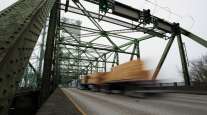Senior Reporter
Delaware Bridge Repair Plan Underscores US Road Needs

This story appears in the May 9 print edition of Transport Topics.
On April 19, the Delaware River and Bay Authority closed three of four southbound lanes on the Delaware Memorial Bridge to begin construction on suspender ropes that inspectors had deemed unsafe.
That day, and the days that followed, transportation agencies in Delaware and New Jersey — the states linked by the bridge — reported massive backups in both directions.
Lee Derrickson, executive director of the Delaware Motor Transport Association, said its members told him they were stuck in traffic for hours on the prominent freight corridor along Interstate 295 in Delaware and the New Jersey Turnpike.
As work continues to replace suspender ropes in the southbound bridge, all but one lane will be closed for the foreseeable future, a spokesman with the authority said, noting the bridge is in good condition. About 45,000 trucks and cars cross the bridge every day, the spokesman added.
Transportation officials, experts, and academicians agreed the emergency repairs on the Memorial Bridge seemed out of the ordinary.
The industry and policymakers see eye to eye on the need to boost funding for infrastructure, but often they disagree on the source of such funding. Starting May 16, these transportation officials and experts will participate in dozens of panels and workshops in Washington and in other cities to draw attention to the issue during Infrastructure Week.
The series of events is produced by the U.S. Chamber of Commerce in partnership with other groups.
“I’m surprised at this. I mean, it’s not really normal for this span,” Derrickson told Transport Topics. “Usually, they’re on top of everything.”
But across the country, the stakeholders acknowledged scenes of emergency crews working on neglected bridges have become all too familiar. Nationwide, nearly 59,000 bridges are deemed structurally deficient and in need of repair, according to a recent analysis by the American Road and Transportation Builders Association.
States mired in budget woes struggle to fund routine bridge inspections and maintenance, which lead to emergency repairs.
“I think there’s some genuine concerns with infrastructure. And I think our infrastructure has been ignored for many years. And it’s a money problem. Nobody can agree on how to pay for it,” Derrickson said.
Michael Chajes, professor and chairman at the Department of Civil and Environmental Engineering at the University of Delaware, belongs to the American Society of Civil Engineers. The group, a key player during Infrastructure Week, said in 2013 the country had earned a D+ grade in infrastructure. ASCE estimates the country must come up with $3.6 trillion by 2020 to rehabilitate deteriorating infrastructure.
Chajes said bridge repairs “will be much more expensive than it would’ve been if we would have treated it incrementally, and the disruptions to traffic are going to be much more significant.”
“I think we’ve as a nation benefited by having a great infrastructure,” he said, “which makes it easy to transport goods and have people be able to travel and have mobility, but that’s gradually going to go away if we don’t pay attention to it.”
Chajes also stressed there are benefits in ensuring states have quality infrastructure devoid of severe traffic congestion.
The American Transportation Research Institute found that congestion nationwide accounted for nearly $50 billion in operational costs for the trucking industry in 2014.
According to ARTBA’s 2016 analysis, structurally deficient bridges between 2014 and 2015 decreased around the country. In California, the number of such bridges was down by 492, followed by Oklahoma with 440 and Pennsylvania at 267. Indiana and Nebraska reduced the number of structurally deficient bridges by 185 and 180, respectively, according to the analysis.
“We know that state DOTs and local governments have been increasing their investment in bridge work over the last 15 years — the real value of investment, taking into account changes in project costs and inflation, has more than doubled,” Alison Premo Black, senior vice president and chief economist with ARTBA, told TT.
She added that while the decline in the number of structurally deficient bridges is good news, “at the current pace, it would take over 20 years to make all these repairs.”
Delaware, best-known for its incorporation business, has one of the lowest number of bridges in need of repairs. ARTBA found that 5% of the 875 bridges in Delaware are structurally deficient, meaning one or more of the key elements of the bridge are in poor or worse condition. Fifteen percent of the bridges are functionally obsolete, which means they do not meet current design standards. Since 2004, 77 bridges have been constructed in the state, and 25 saw major repairs.




